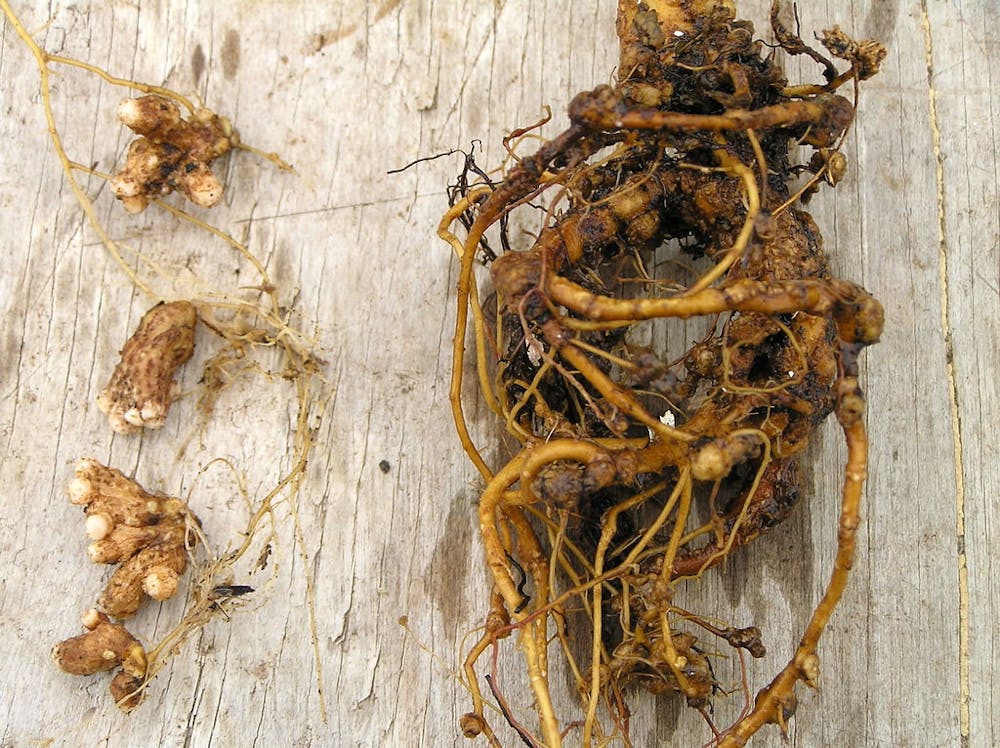
I opened the incubator door, and a familiar whiff of an earthy, repulsive odor attacked my nostrils. I held my breath and slowly took out a stack of yellow gel plates covered with small white dots. This could be the day, I hoped to myself. This was just another round of mutation screening, trying to find that one special bacterial colony with that one specific mutation that could prove our hypothesis.
I am a member of the Belin Lab, whose work focuses on one particularly capricious and picky bacterial species: Bradyrhizobium diazoefficiens (Brady). Yes, the name is a mouthful to speak and most definitely a pain to type. But aside from asking me to repeat this mantra-like name, people always ask me why. Why Brady? Why bacteria? Why not study eukaryotic cells which have much more exciting and complex systems to study? The answer is symbiosis, which is, in general, when two species help each other survive.
Remember the nitrogen cycle that most of us probably learned in high school biology? That is what Brady takes part in. Atmospheric nitrogen on earth cannot be used by biological species. For it to be useful, nitrogen gas needs to be converted to a biologically viable form. Most species, unfortunately, do not have the gift of fixing their own nitrogen. This is where Brady comes in. For example, it lives in the root of soybeans to provide them with usable nitrogen.
Despite the nitrogen cycle being so ubiquitously learned, not a lot of scientists truly understand the factors fostering this important process.
Beyond Brady, bacteria as a whole are important to humans. We literally cannot survive without bacteria. There are bacteria that people desperately try to get rid of with hand sanitizer that can be more than a disease. Some bacteria are essential friends that we need to survive. Playing roles in fundamental human development and maintaining our basic health, bacteria can be more than pathogens.
While I carefully picked 40 samples, pipetted countless more and made sure to not accidentally set my hair on fire with a Bunsen burner, hours passed by. Aside from a plethora of negative samples, I was also left with acute lower back pain. Another day of useless struggles.
Cell and molecular biology research is by no means easy to do. Often, we take a cell biology approach to studying Brady. Through adding fluorescent molecules to proteins or staining bacterial cells with special dyes, we can learn about Brady’s molecular and cellular activities — such as how lipid molecules contribute to membrane order or resistance to harsh environments — via advanced microscopy techniques.
However, all of these experiments are easier said than done. Take mutation screening for example. My mentor and I have been trying to generate mutants that can produce fluorescent versions of important proteins for almost a year. Still, due to unexpected challenges along the way, such as issues with plasmid assembly and the fastidious nature of Brady, we have not been able to reach our goal to this day.
Another example is membrane staining. Brady cells have to be at very specific concentrations and dyes must be mixed with the cell for a very specific time to generate a useful image. The more exact the experiment must be, the greater the possibility of failure.
Nevertheless, the reward I get from studying Brady always outweighs the challenge. Through microscopy techniques, I have been able to see biological structures and processes that are unlike the examples in textbooks. Moreover, it is always fascinating to discover the molecular workings governing the process of symbiosis, seeing how every part of Brady comes together to form a seamless unit.
So, after a long day of errors and failures, my mentor and I plan the next round of experiments. Generating mutations, tagging molecules and running reactions, we wait for the joy of discovering and understanding the potential that Brady has to offer. Yes, the experiments may be tedious and challenging to perform, but when we do succeed and learn new things, the feeling is like no other.





